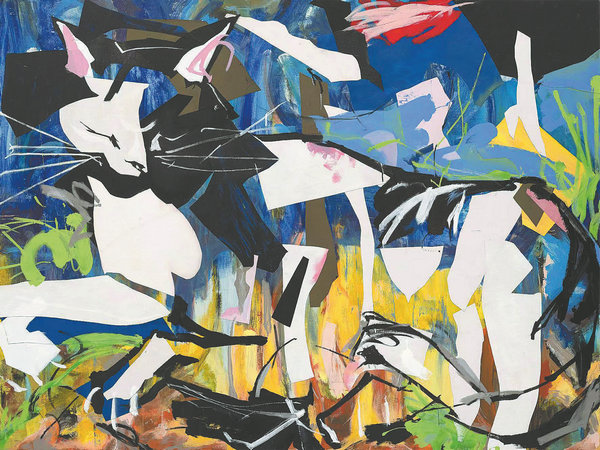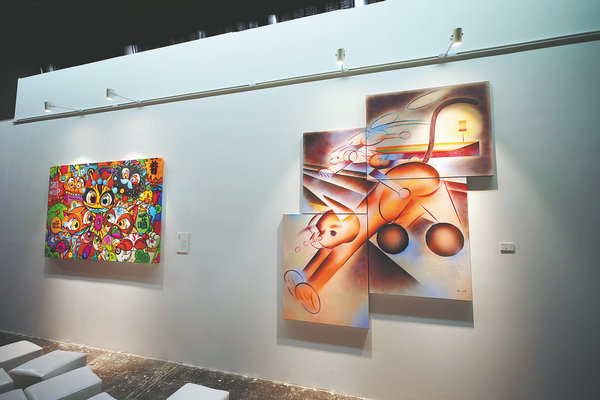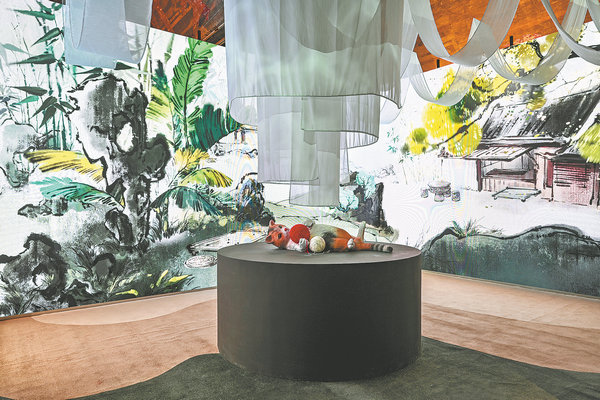Time to 'paws' for reflection

The exhibition Cats of the East presents the charm of our feline friends in diverse and artistic ways. Highlights include oil painting You, Me, It created by Ke Da. [Photo provided to China Daily]
Art show highlights the role cats have played in Eastern culture and their connection with humans, Xu Haoyu reports.
The connection between cats and humans in the East can be traced back more than 2,000 years, as evidenced in the poem Han Yi from the Western Zhou Dynasty (c. 11th century-771 BC), which mentions cats.
Cats have gradually evolved into pets with huge emotional and cultural significance. The literary and artistic expressions and representations of cats throughout history are uniquely insightful.
The exhibition Cats of the East, held in Beijing 798 Art Zone, presents the charm of our feline friends in diverse and artistic ways through vibrant works from home and abroad. It explores the various possibilities of artistic media, conveying the cat's symbolic imagery, cultural associations and emotional appeal through the ages.
At the entrance to the exhibition hall, an animated short film unfolds a scroll depicting idyllic "cat fun" through the form of ink painting — some cats can be seen lazily lying or sitting on the floor; some quietly watching the change of seasons.
The exhibition deconstructs the Chinese character mao (cat) through the form of calligraphy, using different script types to demonstrate ancient people's understanding of cats.
Another highlight is a video, which tells the story of people's first encounter with the Persian cat. The seven-minute-long animation, created by students and teachers from the School of Animation and Digital Arts at the Communication University of China, presents humanistic images of courage, innocence, and love associated with the animal.

The exhibition Cats of the East presents the charm of our feline friends in diverse and artistic ways. [Photo provided to China Daily]
There is an exhibition hall themed around Ukiyo-e, a type of Japanese woodblock printing popular during the Edo period (1603-1867), which offers insight into the unique status of cats in Japan. A mock Japanese izakaya, or tavern, has been built for visitors to chill and take pictures with cartoon-style animals.
Drawing inspiration from the 12th-century scroll painting Along the River During the Qingming Festival, the exhibition hall's corridor has been transformed, with the aid of video, into an ancient bustling city, where cats wander through the market, adorning people's lives with their presence.
The exhibition also introduces a series of contemporary works created using various art forms, such as sculpture and new media. With modern understanding, cats are presented as multiple incarnations of concepts, emotions, symbols and beliefs.
Ke Da, 38, who has been raising cats for over a decade, created an oil painting titled You, Me, It.
"The inspiration for the art piece comes from my experience living with cats and feeding stray cats in the neighborhood. Painting cats is like describing a close family member to me," Ke says.
The artist reveals that the creation process took about a week.
"When I decided to portray stray cats, there wasn't a specific image in my mind. … I see them as a group rather than individuals, and I couldn't express my feelings by focusing on one particular cat," he explains.
"They have their own world, intersecting with our world for only several minutes from time to time. Therefore, the artwork is created in a fragmented style, ultimately forming the image of a cat."
For the first layer of the background, he uses blue to represent the sky, yellow to represent reality, and green to signify nature. The background of the painting is abstract, preparing the environment for the appearance of the stray cats.
For the second layer, he cuts out some fabric and collages some abstract human shapes onto the canvas.
"The first layer represents the real world, while the second layer represents human traces of life. Once this environment is set up, all that's left is to wait for the stray cat to appear. I like to call this process 'finding'. Finally, the cat is outlined, or rather, found. Thus the artwork is completed," Ke says.

The exhibition also includes various art forms, such as sculpture and new media. [Photo provided to China Daily]
The exhibition also set up a salon for people to share their knowledge about cats, and tips for coexistence. What's more, a special Take Me Home stray cat adoption event is held every month during the exhibition period, sharing adoption and care information.
Cheng Pengzi, the curator of the exhibition, has been raising cats since 1991.
There's still a visible bite mark on her arm today, which was left by the first cat she raised, on the day when she returned home from a long business trip.
"The bite communicated its love and its resentment," she says.
Two years ago, Cheng's second cat, Little Tiger, got sick. The illness didn't immediately seem fatal, but the cat started losing weight. Cheng's first thought was that Little Tiger, who was 10 years old at the time, was just getting old.
The illness was only discovered when it had already progressed to the terminal stage, and Little Tiger, sadly, passed away last year. "I realized that I didn't really know or understand cats," she says with a regretful smile.
In the past two years, Cheng has been thinking about the love and connection that she has with her pets and other animal friends. The exhibition for her is like a memoir she keeps, and provides the answers to questions she harbors about the connection between pets and their owners.
Cheng notes that "cats have been imbued with various meanings in global history — mysterious, fantastical or comforting".
"The exhibition invites visitors to explore a series of intertwining concepts pertaining to cats and emotions, and to follow the historical development and evolution of the role of cats in Eastern civilization," she says.
"Through the perspectives of humans observing cats, and cats observing humans, it presents various aspects of human nature and societal life."
Wang Lei, the dean of the School of Animation and Digital Arts at the Communication University of China, who also curated the exhibition, believes that history is made up of specific individuals.
"When we observe a specific person or even a cat in a particular era, we discover a different story from a unique angle," he says.
As a leading figure in Chinese animation, the director and screenwriter hopes to perfectly express both the relationship between cats and humans, and the relationship between humans and historical culture, through the exquisite presentation of digital art.
One visitor, Wang Tebie, comments: "The exhibition is a furry love letter to cats."
The exhibition runs until Oct 8.
If you go
Monday to Friday, 10 am to 7 pm (last admission at 6:30 pm); Saturday, 10 am to 8 pm (last admission at 7:30 pm), until Oct 8.
798 Art Factory, 798 Art Zone, 4 Jiuxianqiao Road, Chaoyang district, Beijing.
